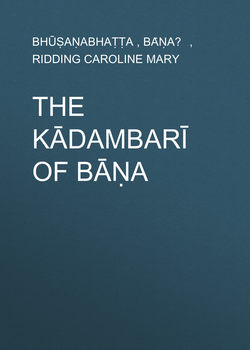Читать книгу The Kādambarī of Bāṇa - Bhūṣaṇabhaṭṭa - Страница 11
INTRODUCTION.1
The Plan of the Translation
ОглавлениеThe translation of Bāṇa presents much difficulty from the elaboration of his style, and it has been a specially hard task, and sometimes an impossible one, to give any rendering of the constant play on words in which he delights. I have sometimes endeavoured to give what might be an English equivalent, and in such cases I have added in a note the literal meaning of both alternatives; perhaps too much freedom may have been used, and sometimes also the best alternative may not have been chosen to place in the text; but those who have most experience will know how hard it is to do otherwise than fail. Some long descriptions have been omitted, such, e. g., as a passage of several pages describing how the dust rose under the feet of Candrāpīḍa’s army, and others where there seemed no special interest or variety to redeem their tediousness. A list of these omissions33 is given at the end, together with an appendix, in which a few passages, chiefly interesting as mentioning religious sects, are added. I have acted on Professor Cowell’s advice as to the principle on which omissions are made, as also in giving only a full abstract, and not a translation, of the continuation of ‘Kādambarī’ by Bhūshaṇa. It is so entirely an imitation of his father’s work in style, with all his faults, and without the originality that redeems them, that it would not reward translation. In my abstract I have kept the direct narration as more simple, but even when passages are given rather fully, it does not profess in any case to be more than a very free rendering; sometimes only the sense of a whole passage is summed up. I regret that the system of transliteration approved by the Royal Asiatic Society came too late for adoption here.
The edition of ‘Kādambarī’ to which the references in the text are given is that of the Nirṇaya-Sāgara Press (Bombay, 1890), which the full commentary makes indispensable, but I have also throughout made use of Professor Peterson’s edition (Bombay Sanskrit Series, No. xxiv.). For the last half of the Second Part34 I have referred to an anonymous literal translation, published by the New Britannia Press Depository, 78, Amherst Street, Calcutta.
I have now to offer my grateful thanks to the Secretary of State for India, without whose kind help the volume could not have been published. I have also to thank Miss C. M. Duff for allowing me to use the MS. of her ‘Indian Chronology’; Miss E. Dale, of Girton College, for botanical notes, which I regret that want of space prevented my printing in full; Mr. C. Tawney, librarian of the Indian Office, for information as to the sources of Indian fiction; Mr. F. F. Arbuthnot and Professor Rhys-Davids, for valuable advice; Professor C. Bendall, for his description of the Kāmandakīya-Nīti-Çāstra, and his constant kindness about my work; Mr. F. W. Thomas, of Trinity College, for letting me see the proof-sheets of the translation of the ‘Harsha Carita’; and others for suggested renderings of difficult phrases, and for help of various kinds.
But especially my thanks are due to Professor Cowell35 for a generosity and unwearied helpfulness which all his pupils know, and which perhaps few but they could imagine. I read through with him the whole of the First Part before translating it myself, so that mistakes in the translation, many as they may be, can arise only from misunderstanding on my part, from too great freedom of rendering, or from failing to have recourse to the knowledge he so freely gives.
‘Vṛihatsahāyaḥ kāryāntaṃ kshodīyānapi gacchati;
Sambhūyāmbodhim abhyeti mahānadyā nagāpagā.’
33
The list looks long, but the pages in the ‘Nirṇaya-Sāgara’ edition contain frequently but few lines, and many of the omissions are a line or two of oft-repeated similes.
34
Beginning at p. 566 of the ‘Nirṇaya-Sāgara’ edition.
35
I here take the opportunity to acknowledge what by an oversight was omitted in its proper place, my indebtedness to Professor Cowell for the rendering into English verse of two couplets given on pp. 11 and 113.
